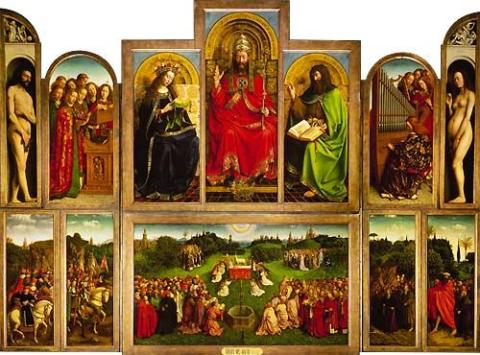The Altarpiece
Descriptions, examples, and links
An altarpiece is a carving, painting, sculpture, screen or decorated wall
made for a Christian church altar, the table at which mass is said. They
vary enormously in size and conception, from tiny portable pictures to
huge structures embracing the arts of architecture, sculpture and painting.
Normally, the altarpiece rests on the altar, but it is also found behind
or even above. The centre of the altarpiece features a depiction of Christ,
the Virgin Mary or a saint, with the side panels generally showing scenes
relating to the life of the central figure. These are presented in chronological
order and can be read like a comic strip. The backs of the side panels
are almost always painted, giving a finished aspect to the altarpiece
when closed. Sometimes panels are attached along the bottom; this is referred
to by the Italian term 'predella'.
Predella: A subsidiary picture forming an appendage to a larger one, especially a small painting or series or paintings beneath an altarpiece.
Altarpieces divide into two main types: the reredos, which rises from ground level behind the altar, and the retable, which stands either on the back of the altar itself or on a pedestal behind it. Many altars have both.
Source: © 14 Oct 2002, Nicolas Pioch - Top - Up - Info
Thanks to the BMW Foundation, the WebMuseum mirrors, partners and contributors
for their support. - http://www.ibiblio.org/wm/paint/glo/altarpiece/

The Ghent Altarpiece by Jan Van Eyck
http://www.artofeurope.com/van_eyck/eyc3.htm
Defining the Altarpiece
Altarpiece
There are many kinds of altarpieces, and you have been given examples in previous weeks. The basic definition of an altarpiece is that it is a picture of some sacred subject painted on the wall or suspended in a frame behind the altar, or a group of statuary on the altar. Altarpieces have evolved over the century, but in the Middle Ages, instead of a picture or group, the altarpiece consisted in some churches of embossed silver or gold and enamelled work set with jewels. Sometimes the piece was set on the altar itself. Sometimes a folding door was attached which covered the picture during the year, and was opened on grand festivals to expose the picture. If it was a movable structure, it was made of hammered silver or other precious material, supported on the altar itself. The face of this structure which looks towards the nave of the church is called the "retable", and the reverse is called the "counter-retable". This decoration of the altar was not known before the twelfth century. It should always correspond to the architecture or style of the church. The best models are found in the churches of St. Sylvester in Capite, Sta. Maria del Popolo, della Pace and sopra Minerva, at Rome. When this structure is ornamented with panels and enriched with niches statues, buttresses, and other decorations, which are often painted with brilliant colours, it is called a "reredos". Sometimes the reredos extends across the whole breadth of the church, and is carried nearly up to the ceiling. This decorative screen, retable, or reredos is also called the altarpiece.
Different kinds of altarpieces.
Diptych
A diptych is a picture or work of art consisting of two parts facing each
other like the pages of a book, and hinged together.
Triptych
A triptych is a picture in three compartments side by side, the lateral
ones being subordinate or hinged so as to fold over the central one. This
was especially good for religious images that could be carried. Last week's
Masaccio's Virgin, Child and Saints is an example of the form.
Polyptych
A polyptych is a picture or other work of art, typically an altarpiece,
consisting of four or more leaves, usually hinged together.
Predella
A predella is small picture, an appendage to a larger one, especially
a small painting or series of paintings beneath an altarpiece.
Fragments
As discussed a few weeks ago, a fragment is part of an altar, usually
a small picture, that has become separated from its original altarpiece.
Source: http://www.art-history-online.info/pages/ahoexeter03.htm
Links:
Madonna with the Child, Saints and Crucifixion - Fra Angelico
http://www.kfki.hu/~arthp/html/a/angelico/altar/sanmarco/altar_sm.html
Matthias Grunewald
http://www.anthroposophy.org.nz/Sections/Medical/Grunewald.htm